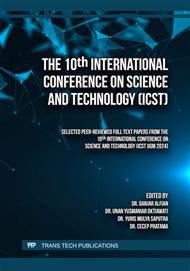[1]
Casey, Michael. 2015. Global Cost of Flooding to Increase Tenfold by 2030 https://www.cbsnews.com/news/global-cost-of-flooding-to-increase-tenfold-by-2030/
Google Scholar
[2]
Gofur, Abdul. 2021. Kerugian Akibat Banjir di Katingan Ditaksir Lebih dari Rp 600 Miliar https://www.borneonews.co.id/berita/236291-kerugian-akibat-banjir-di-katingan-ditaksir-lebih-rp-600-miliar
DOI: 10.31227/osf.io/qa5gh
Google Scholar
[3]
Kron, W. Keynote lecture: Flood risk= hazard× exposure× vulnerability. Flood Def. 2002, p.82–97. Tersedia online di https://www.iahr.org/library/infor?pid=16216 (diakses 19 Oktober 2024)
Google Scholar
[4]
Amen, Aumed Rahman M., Mustafa, Andam., Kareem, Dalshad Ahmed., Hameed, Hasan Mohammed., Mirza, Ayub Anwar., Szydlowski, Michal., & Saleem, Bala Kawa M. 2023. Saleem. 2023. "Mapping of Flood-Prone Areas Utilizing GIS Techniques and Remote Sensing: A Case Study of Duhok, Kurdistan Region of Iraq" Remote Sensing 15, no. 4: 1102
DOI: 10.3390/rs15041102
Google Scholar
[5]
Legislation of Indonesia Number 24/2007 about Disaster Mitigation
Google Scholar
[6]
Ozkan, S. P., & Tarhan, C. (2016). Detection of flood hazard in urban areas using GIS: Izmir case. Procedia Technology,22, 373–381.
DOI: 10.1016/j.protcy.2016.01.026
Google Scholar
[7]
Abdo, H. G., Zeng, · Taorui, Alshayeb, M. J., Prasad, P., Fatahalla, M., Ahmed, M., Jasem, ·, Albanai, A., Maged, ·, Alharbi, M., & Mallick, · Javed. (n.d.). 2024. Multi-criteria analysis and geospatial applications-based mapping flood vulnerable areas: a case study from the eastern Mediterranean. Natural Hazards
DOI: 10.1007/s11069-024-06864-y
Google Scholar
[8]
Sugumaran, Ramanathan & John Degroote. 2011. Spatial Decision Support System: Principles and Practices. Boca Raton: CRC Press
Google Scholar
[9]
Dyah Sukowati, K. A., & Kusratmoko, E. 2019. Analysis of the distribution of flood area in Karawang Regency using SAR Sentinel 1A image. IOP Conference Series: Earth and Environmental Science, 311(1), 012085
DOI: 10.1088/1755-1315/311/1/012085
Google Scholar
[10]
Faisol, Arif., Bachri, Samsul., & Mashudi. 2024. Komparasi Data Digital Elevation Model (Dem) Resolusi Menengah Dalam Mengestimasi Ketinggian Lahan Di Kabupaten Manokwari Provinsi Papua Barat. Majalah lmiah lobe, 26(1), 11–20. https://jurnal.big.go.id/GL/article/view/137
DOI: 10.24895/gl.2024.26.1.11-20
Google Scholar
[11]
Fakhruddin, Akmal Wahyu., & Harindataka. 2019. Analisis Akurasi Vertikal Model Elevasi Digital Nasional [Bachelor Thesis, Universitas Gadjah Mada]. Universitas Gadjah Mada Electronic Theses & Dissertations
DOI: 10.20885/jattec.vol5.iss1.art9
Google Scholar
[12]
Minister Regulation of Ministry of Environment and Forestry number 10/2022 about Forest and Land Rehabilitation In River Water Area and Annual Plan For Forest and Land Rehabilitation
Google Scholar
[13]
Sahu, A., Bose, T., & Samal, D. R. 2021. Urban Flood Risk Assessment and Development of Urban Flood Resilient Spatial Plan for Bhubaneswar. Environment and Urbanization ASIA, 12(2), 269-291. https://doi-org.ezproxy.ugm.ac.id/
DOI: 10.1177/09754253211042489
Google Scholar
[14]
Razzaghi Asl, S., & Pearsall, H. 2023. How do spatial factors of green spaces contribute to flood regulation in urban areas? A systematic mapping approach. Progress in Physical Geography: Earth and Environment, 47(5), 702-720. https://doi-org.ezproxy.ugm.ac.id/
DOI: 10.1177/03091333231156511
Google Scholar
[15]
Hagos, Y. G., Andualem, T. G., Yibeltal, M., & Mengie, M. A. (2022). Flood hazard assessment and mapping using GIS integrated with multi-criteria decision analysis in upper Awash River basin, Ethiopia. Applied Water Science, 12(7)
DOI: 10.1007/s13201-022-01674-8
Google Scholar
[16]
Dewan, A., Kankam-Yeboah, K., & Nishigaki, M. 2006. Using Synthetic Aperture Radar (SAR) Data for Mapping River Water Flooding in an Urban Landscape: A Case Study of Greater Dhaka, Bangladesh. Journal of Japan Society of Hydrology & Water Resources, 19, 44–54
DOI: 10.3178/jjshwr.19.44
Google Scholar
[17]
Surampudi, S., & Yarrakula, K. 2020. Mapping and assessing spatial extent of floods from multitemporal synthetic aperture radar images: a case study on Brahmaputra River in Assam State, India. Environmental Science and Pollution Research, 27(2), 1521–1532
DOI: 10.1007/s11356-019-06849-6
Google Scholar
[18]
Uddin Kabir and Matin, M. A., & T. R. B. 2021. Rapid Flood Mapping Using Multi-temporal SAR Images: An Example from Bangladesh. In R. B. and M. M. A. Bajracharya Birendra and Thapa (Ed.), Earth Observation Science and Applications for Risk Reduction and Enhanced Resilience in Hindu Kush Himalaya Region: A Decade of Experience from SERVIR (p.201–210). Springer International Publishing
DOI: 10.1007/978-3-030-73569-2_10
Google Scholar
[19]
Muttaqin, K., Maulita, M., Fitria, L., Ihsan, A., & Mulya, R. (2023). Mapping Flood-Prone Areas Based Geographic Information System Using Composite Mapping Analysis. International Journal of Geoinformatics, 19(12), 93–105
DOI: 10.52939/ijg.v19i12.2983
Google Scholar


